Eco-Friendly Essential Oil Inhaler Alternatives
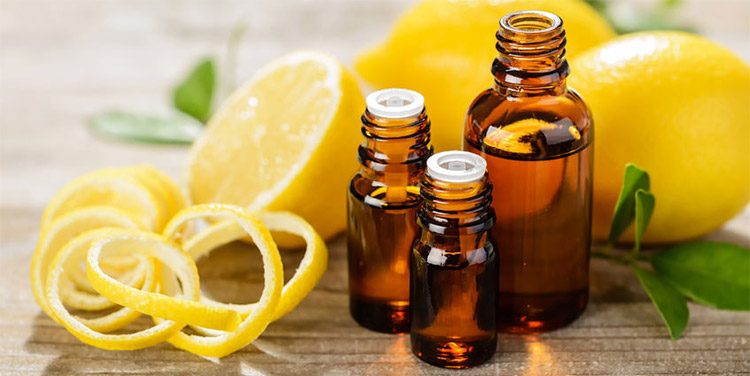
Essential oil inhalers are also known as nasal inhalers, aromatherapy inhalers, and sometimes aroma sticks or sniffy sticks.
I love using essential oil inhalers when I'm out and about. Inhalers are so portable and make it easy to keep blends handy that you might need while you're traveling, out during the day or while in situations that don't allow you to use a diffuser. Inhalers are also helpful at home so that you can benefit from blends that may not be suitable to diffuse in the proximity of your children or pets.
I don't find the aroma of essential oil blends to be as pleasing when confined in an essential oil inhaler in comparison to using the blend in other applications or in comparison to using a fragrance test strip, but the purpose of using an inhaler is more for portability of a therapeutic blend.
Tip: If you're not familiar with essential oil inhalers, or the typical types available, I'd recommend first reading AromaWeb's Aromatherapy Inhaler Guide. Then, come right back to read this article.
A Dilemma With Typical Essential Oil Inhalers
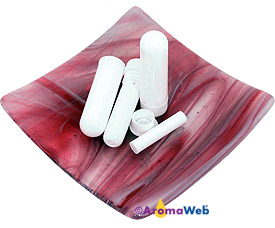
The most commonly available type of essential oil inhaler is made of "disposable" plastic components. I love how effective they are. Their design allows for effective air flow when inhaling the essential oil contained on the wick. However, the plastic composition of the inhaler is a concern for the environment, particularly since most people dispose of them once the aroma has faded over a few weeks.
Using plastic essential oil inhalers for an extended period of time can potentially be risky. The essential oil soaked wick can easily come into contact with the interior sides of the vessel, even if you first start by mounting the wick into the cap - it's easy for the wick to pop out at some point. The plastic then can potentially break down over time due to that exposure, and we could wind up inhaling toxins from the plastic. When plastic breaks down, it's not something we will necessary "notice."
Solution #1: Re-Usable Aluminum Inhalers
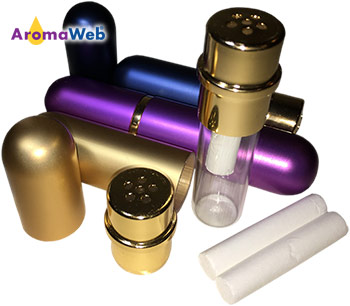
Re-usable inhalers are available that are made of a painted aluminum exterior. The cotton wick is encased in an interior glass vial with metal screw-top cap with air holes.
Benefits:
These types of inhalers are far more eco-friendly than the plastic disposable types.
Disadvantages:
I've heard a few complaints from others (and I share the same complaint) that the aroma of the blend can smell weaker when using this type of inhaler than when using the disposable plastic type. I've compared both types of inhalers, and with those brands that I've used, the wicks inside the plastic essential oil inhalers tend to be held in place closer to the air hole openings than with the re-usable aluminum essential oil inhaler types. Plastic inhalers also tend to have air holes towards the bottom, allowing for better air flow as you inhale.
You can try to compensate for the lack of aromatic strength of aluminum/glass encased essential oil inhalers by using tweezers to pull the wick out of the glass vial ever so slightly so it's sticking out a little. However, you want to be careful because you don't want a saturated wick to leak out of those air holes and come into direct contact with your nose or fingers (or anything else for that matter).
Solution #2: Make Your Own Essential Oil Inhaler
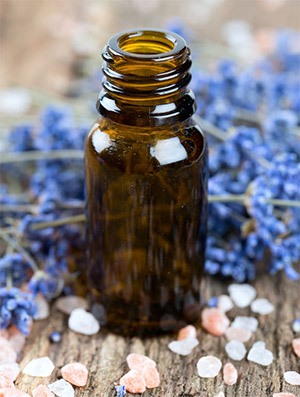
It's easy to make your own essential oil inhaler by simply starting with an empty 5ml essential oil bottle, filling it approximately 3/4 of the way with salt, and then adding several drops of essential oil. I prefer to use fine grain pink Himalayan or Bolivian salt. Cap the bottle when not in use so that the essential oil doesn't evaporate as quickly. Other size bottles can also be used, but the 5ml bottle size seems to work best.
Less is more with essential oils, so experiment at first by using just a couple drops. Use care not to make your inhaler too potent.
To Use Your Salt Based Essential Oil Inhaler:
To use this type of aromatherapy inhaler, simply take off the cap, raise the bottle to 1-2" away from your nose and inhale. Be careful, however, to make sure that you don't accidentally inhale any of the salt. I haven't had that happen yet, but I could see that possibly happening if overfilled the bottle with salt or inhaled really quickly and deeply.
Benefits:
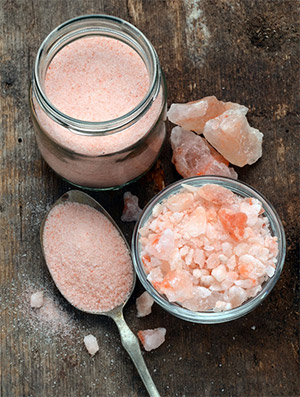
As of this writing, this is the most affordable and eco-friendly solution that I've found for essential oil inhalers. This is a good application for reusing empty essential oil bottles after you've used up the essential oil. (For information on how to clean essential oil bottles, see AromaWeb's Guide to Cleaning and Reusing Essential Oil Bottles.)
Once the aroma has faded, you can easily add more essential oil to your handmade essential oil inhaler, or you replace the salt with fresh and add a different essential oil or blend.
Disadvantages:
This type of essential oil inhaler is not as portable in some cases because there is the risk of dropping or tipping the bottle, causing the salt to spill everywhere. This can be particularly risky if driving, so do not use this type of inhaler while driving or doing something that requires full concentration. It can also be messy if you accidentally dump it in your purse or spill it all over yourself. As mentioned above, there is the potential risk also of accidentally inhaling some of the grains of salt. I haven't had that happen yet, but I see this as a possibility.
Solution #3: Simple Alternatives to Essential Oil Inhalers
These final two alternatives are technically considered methods of passive diffusion...
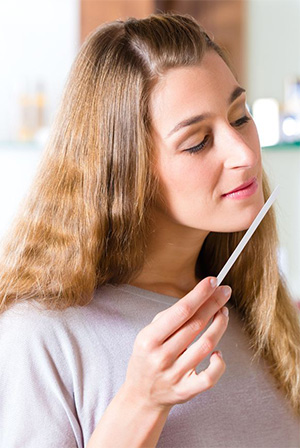
I love using fragrance test strips as a quick and alternative for inhaling an essential oil or blend over the course of a short duration of time. They're intended for use in evaluating aroma, but they are a useful and economical alternative when an inhaler isn't practical, available or necessary for your purpose. You can stand them up by sticking one end in a small essential oil bottle filled with salt. You can also elevate them by using the small, lightweight photo memo clip stands that are intended to display single photos.
Last but not least, a very obvious alternative is the use of a simple cotton ball. However, as with the fragrance test strip alternative, the aroma will dissipate quite quickly.
